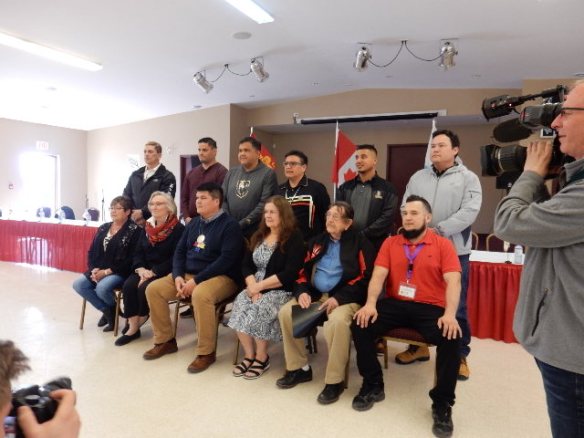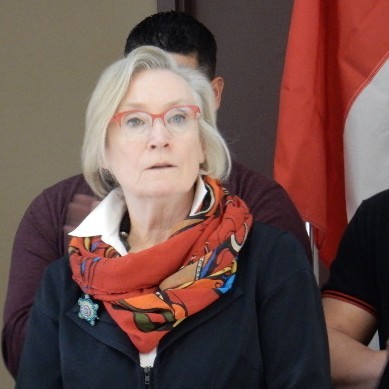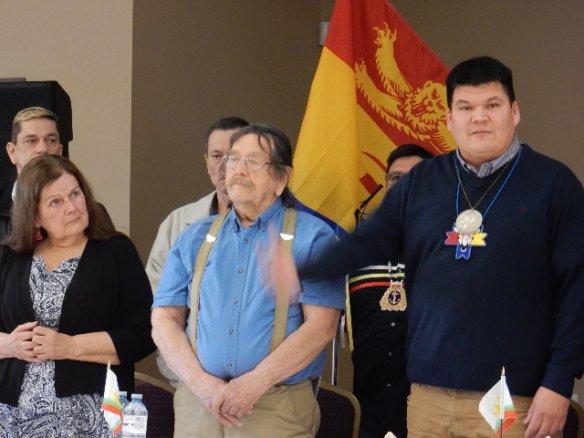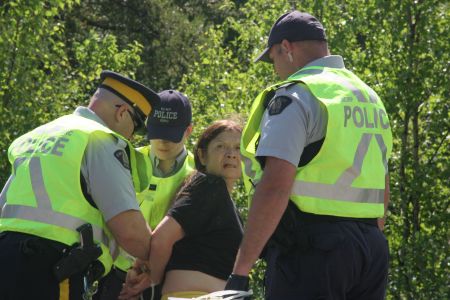byline: Ann Pohl, May 10 2019, Bass River NB
Yesterday, May 9 2019, Elsipogtog Chief Arren Sock and the federal Minister of Crown-Indigenous Relations Carolyn Bennett signed a Memorandum of Understanding (MOU). In the words of the Minister, this is a “blank piece of paper” that only spells out “how we will work together.”

There certainly was a LOT of media interest in this MOU signing!
It’s the morning after and can we all still respect ourselves?
My answer is yes, at least from the grassroots Sikniktuk/Kent County point of view. As Chief Sock said, raising high a known symbol for warfare – the hatchet – “we are not burying this yet.” Its hard to be certain what is going through the Puppet Master’s heads in Ottawa, but for her part Carolyn Bennett seemed sincere when she said, “We know we’ve got a lot of work to do to rebuild that trust.”

Carolyn Bennett, Canada’s Minister of Crown-Indigenous Relations, at Elsipogtog First Nation on May 9 2019 for MOU signing.
Yes, there is a lot of work to do repairing this relationship… It has been continuously undermined on the Settler Government side since the British colonial government instituted a bounty payment for Mi’kmaq scalps back in the 1740’s. Then there are all the genocidal programs enacted during the past 150 years since Canada became its own nation, including residential schools… Inequitable child welfare and school funding, undrinkable water, murdered and missing mothers, aunties, daughters, and sons…
And, both leaders could have been mentally referencing how the federal government’s police force – the RCMP – aggressively backed an oil and gas corporation during the 2013 anti-fracking action here. The federal Civilian Commission got its first complaints about human rights violations by the RCMP six years ago, and the public still has not seen their report. Apparently, it has been languishing in “final edit” stage for months.
Here in Sikniktuk – the 6th District of Mi’kma’ki, which translates as the “drainage area” because of the vast wetlands, streams, creeks, and rivers that flow into the sea from this region – the Mi’kmaq Peoples and their non-Indigenous allies in all surrounding communities, stand by, watching to see how this all unfolds.

Sikniktuk is the area in black bold outline;
taken from Elsipogtog’s Title Claim document.
As of yet, the text of this MOU has not been released (see Global), though it is fair to assume it will be available soon.
It is common knowledge that, under the Indian Act, every single member of the Indigenous community must be consulted on all matters pertaining to Title and Inherent Rights. These are held collectively by all members of the community, and the Indian Act does not authorize an Indian Act Band Chief – like Arren Sock – nor his Band Council – to alter these rights through their own action. These decisions must be made by the entire community. Chief Sock has previously demonstrated that he honours and understands how democracy is done, in how he strongly backed the community will around the fracking issue. Being a humble man, he would probably just say he was learning on the job…
For its part, since it opened its doors in 2014, Kopit Lodge has always maintained transparent practice.
As soon as lawyers talk with lawyers, etc., here’s betting that we will all see that MOU and know exactly what is in it. Besides, if all else fails, the Elsipogtog community is well-informed and legally adept, so someone will get a copy of the MOU through a freedom-of-information access request.
My own guess is that what is in that MOU is almost exactly what we heard yesterday: basically there are still two solitudes, talking across each other to their own constituencies, but trying to be polite and hoping valiantly for a miracle breakthrough in communication and understanding.
At the outset, the two national leaders had considerable common ground. “This signing demonstrates our commitment to working as partners…” was how Minister Bennett was quoted in The Toronto Star. Just a few minutes earlier, Chief Sock had said, “We have to work together in collaboration, and that brings us here today” (CBC.ca).

Chief Arren Sock and Minister Carolyn Bennett after they have signed the MOU.
But then look at the fine print.
As she spoke to the media when the MOU was being signed, Bennett acknowledged the “trauma and damage” inflicted through colonization on Indigenous Peoples. She emphasized the federal thrust behind the MOU is to help get the Mi’kmaq out from under the Indian Act, and to “find solutions that will help close socio-economic gaps and advance reconciliation” (from The Toronto Star). Bennett stressed, repeatedly, the federal position that they seek to “renew their relationship based on recognition of rights, respect, co-operation and partnership.”
For his part, Sock spoke on an entirely different rationale behind the MOU. He recalled the anti-fracking protests in 2013 and explained that “never again” should his community have to go through that.
“This is our land, and we decide what happens to it,” said Sock as he referenced the November 2016 Title Claim filed by Chief Sock, together with elder Kenneth Francis, a community volunteer and the Speaker for Kopit Lodge. This Claim, against the federal and provincial governments, is to gain full recognition through the courts that the Mi’kmaq have never ceded their territory or any of the inherent rights that arise from their territory. They seek this recognition in order to control any development in their region, so as to protect the water, forests, land and communities in Sikniktuk, which makes up roughly one-third of the province of New Brunswick. Both Francis and Sock are clear that they seek full recognition of Indigenous Title, not just for themselves and their children, but for all future generations of all Peoples and Life.

Chief Sock crediting the valuable role of Kopit Lodge on advancing the Title Claim.
Furthermore, because “Politics is always in an electoral cycle, that comes and goes like the tides,” Sock said, he is confident in the enduring legacy offered by Kopit Lodge. Kopit Lodge is a grassroots community organization that operates at arms length to monitor and advise Elsipogtog politicians on management of resource extraction industries in their region. At the same time, the Kopit’ers work closely with a large and diverse set of allies in Sikniktuk and across the region.
Sock commented yesterday that proceeding through the courts to settle this Title Claim could become “a long and drawn-out legal battle” (ATV news video). He favours taking the MOU route for now, as it is best to try “to negotiate” – “we don’t want to go to court” if there is another way to the same end (see Global).
Although the federal and the provincial governments filed replies in 2017 denying the content of the Elsipogtog Title Claim, from early days the federal government said they would prefer to talk this through than go to court. Up to now, the province of New Brunswick has not come to the table to talk. One would think they are still hoping this issue will just go away… The only member of the New Brunswick government present at this MOU-signing event was our provincial MLA for Kent North, the riding where Elsipogtog is located. MLA Kevin Arnseneau, who is a member of the Green Party caucus in Fredericton, was an honoured guest at yesterday’s event.
“Today has the potential of making history for the Mi’kmaq People,” commented Arseneau afterwards to this reporter. “We will never be able to make up for 400 years of colonialism, but we sure can look forward in an honest and meaningful way. To do so, the provincial government must be part of these important conversations. Their absence was noticeable, and makes you think, do we actually have a Aboriginal Affairs Secretariat in New Brunswick? But it’s not to late to step up!”
For his part, New Brunswick’s Aboriginal Affairs Minister Jake Stewart told Fredericton reporters yesterday that his department had let discussions with the federal government and Elsipogtog lapse since last October, “but Chief Sock, Chief Arren, did send me a request to be a part of the MOU on April 25th” (see Global). To explain why the province did not officially attend, Stewart offered, “I’m not sure that would have been enough time for us to really be a participant, but what I’m doing right now is looking at how we might be to participate in the process” (ATV news video). He said he’s told the premier about the request, and they will explore their possible involvement.
On why this MOU is important, once again the two leaders converged. Bennett said, “It used to be the People had to claim their rights, then had to go to court to prove their rights” (Global), But, by using the dialogical process set out in this MOU, “We’re saying no – we’re starting with the recognition of rights” and then working together to resolve “outstanding issues” (CBC.ca). Sock said, we are going to the table to “discuss how we can achieve reconciliation in a manner that recognizes and respects our title and rights” (Global).

Kopit Lodge Speaker Kenneth Francis emphasizing that this process is to see if and “how the relationship between Elsipogtog and the federal government can be reconciled.”
When Kenneth Francis, Speaker for Kopit Lodge, took his turn at the microphone, he said what every local resident present wanted to hear: “This is about protecting the land and the water… It is not a negotiation process where Title could be extinguished. The land is ours.” Kopit Lodge supports the MOU so that we “have this respected.”
What are Elsipogtog allies thinking so far? Debbie Hopper is Chair of the local Kent County NB Chapter of the Council of Canadians, whose members were shoulder-to-shoulder with the Mi’kmaq People of Elsipogtog in 2013. She commented, “I feel proud to stand with Kopit Lodge through all these years.”

Members of the Kent County Council of Canadians and MLA for Kent North Kevin Arseneau at the close of the MOU signing, together with
Kopit Lodge leaders Serena and Kenneth Francis,
Minister Bennett, and Chief Sock.
Hopper continued, “Kopit’s mission is to protect the water. I have watched both provincial Liberal and Conservative governments make devastating decisions about “Crown Land,” which was originally all Indigenous land. These government decisions enabled corporations to put our water in serious jeopardy. I have faith in Kopit Lodge’s core values to act as stewards and conserve the land for the next seven generations. The way New Brunswick is going right now, our forests will be gone long before then and that will add enormous pressure to climate collapse. We all need Indigenous traditional values protecting our future!”
Stay tuned. This is only the beginning. As Chief Sock said during the meal after the signing, “The hard work is about to start.”

Violence during this unnamed grandmother water protector’s arrest on Aboriginal Peoples Day in 2013 is just one of many outstanding complaints. All area residents will be watching how this MOU unfolds. We stand united to protect the water!
To send us comments on this article, please write to coc.kent.county.nb@gmail.com.
